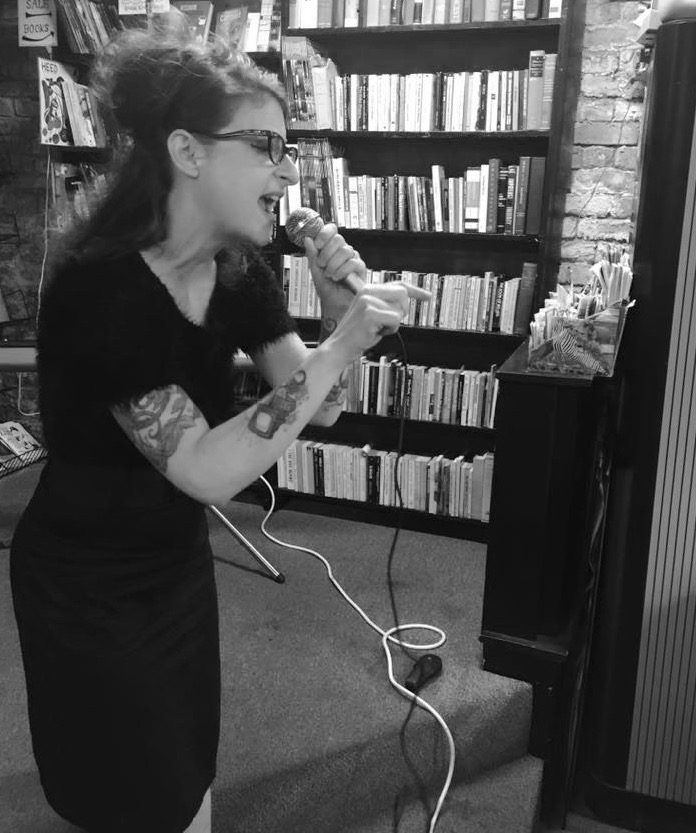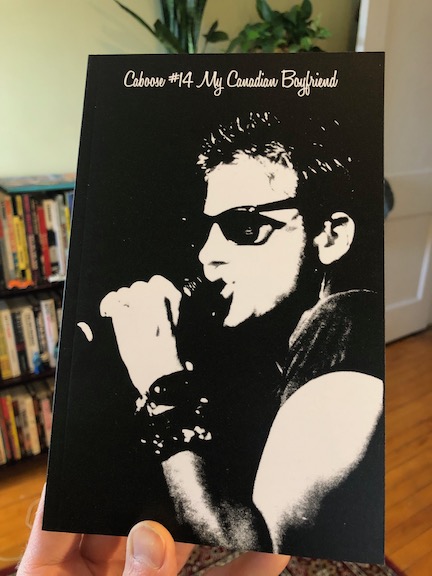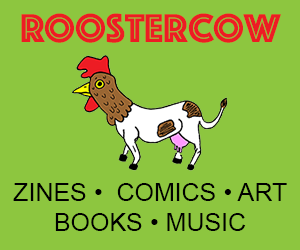
Liz Mason Zine Interview
I first met Liz Mason at a zine fest here in Chicago way back in the day (1998!). It was so long ago, in fact, that the zine fest was called ‘Zine Fest’ and that didn’t even seem generic at the time. This event, sponsored by the Onion, took place at the Charybdis Multi-Arts Complex just down the street from Quimby’s Bookstore which was celebrating its grand reopening that very weekend.
Many zines have been brought forth unto the world since then and quite a few of those were created by Liz, who has also served as shop manager of Quimby’s for 20+ years.
Liz recently published #14 of her long-running zine, Caboose. Titled “Canadian Boyfriend,” this issue takes a deep dive into Liz’s adolescent fixation with Canadian rock star Corey Hart. It’s part perzine, part sociological examination of fandom, and a wholly entertaining read.
I sent Liz a few questions about her ’80s obsession with Corey Hart specifically and her zines generally and she was gracious enough to answer, so grab a Tab diet soda and enjoy! —Chris Auman, 2023
REGLAR WIGLAR: Can you tell us a little about Caboose #14: Canadian Boyfriend?
LIZ MASON: It’s a look at my obsession with Corey Hart when I was between the ages of 9 and 14-ish, in the mid to late ‘80s. I still have all the swag: the t-shirts, the key chains, the magazine clippings, the pin-ups, the fan club newsletters, all that stuff.
I have written about him a little bit in the past but not extensively. Then I noticed that Corey was having a resurgence in a nostalgic kind of way — his music appearing in a bunch of places on TV, in advertising, movies — that it made me think to myself, “Well, the time is now to write about this.” It also happened to coincide with my interest in researching parasocial relationships, studying the original work by the sociologists Horton and Wohl at the University of Chicago in the ‘50s, who came up with the term “parasocial” (though they spelled it with a dash, as in “para-social”) that made me compare it to my own pre-teen obsession, looking at the different shades of fanship.
So it’s part fanzine, part academic investigation, but also a look at neural nostalgia, the way we process music and so much more. Really though, I think it’s just good nerdy fun.

“‘Never Surrender’ was a very easy lyric to write for me because it’s always been something I tell myself. When I was growing up and fighting to get my music off the ground, I’d always tell myself to never quit.”
— Corey Hart, Tiger Beat interview, 1985
RW: Was this issue a struggle for you to write or was it similar to what Corey experienced when writing the lyrics to “Never Surrender”?
LM: Never Surrender, indeed. Getting to the finish line with Caboose #14 was difficult because I’m such a perfectionist. I do so many drafts, and the writing could just go on forever if I don’t have some kind of deadline. I actually worked on this thing for so long that I had to recruit friends to look at it because I couldn’t even tell if it made sense anymore.
There were definitely some “dark night of the soul” moments, not unlike Corey in the “Never Surrender” video, where he’s rocking back in forth in a room with the rain falling, which I can sort of psychically grok. I am a prolific writer but it is a struggle to be both concise and satisfied with my work. Also, because some of what is included in the zine is based on sociological research, science writing, and music criticism, I was using my writing to work out an understanding of the material I was reading.
On top of that, I was also trying to formulate my own original critical theories as well as attempting to make it be entertaining and relevant to readers. How do you be both universal and idiosyncratic in an interesting way? It wasn’t always fun. But I still felt compelled to do it. And of course, trying to add humor to all of that was the part I liked the best, though it is also the hardest part. I will always maintain it is harder to make people laugh than it is to make them cry.
“I have to admit — I’m a bit nervous about being a headliner. I was always an opener before. It’s exciting to know the 30,000 people have come to see you — but at the same time, it’s much harder to play a two-hour set instead of the 45-minute set I’m used to.”
— Corey Hart, Teen Beat interview, 1986
RW: Canadian Boyfriend is a whopping 130 pages! That’s a big jump from previous issues. I wonder if you felt like Corey did when he went from an opening act to a headliner?
LM: Wow! That’s just like my 30,000 fans and followers that are so excited to have this in their hands! Just kidding. I joke that I write for an audience of fifteen people. Corey making the move from being the opener for Rick Springfield or Hall and Oates to headlining at stadiums is 100% exactly like the transition of saddle-stitched zine to perfect bound paperback book, ha ha. But in all honestly, when I did Caboose #7 it was actually 142 pages and was also perfect bound, so the truth is this isn’t even the longest thing I’ve done. And I did also co-edit and do the design for the Quimby’s oral history Ever Evolving Bastion of Freakdom which was 132 pages. That was saddle-stitched though, so I guess that’s a like going from opening for Rick Springfield to opening for Hall and Oates.
RW: As Corey told Rock Express in 1986, “My fans know I’m sincere and write from the heart.” Do you feel that you have that same connection with your readers?
LM: Ah yes, he most definitely writes from the heart and it is super poetic that his last name is Hart (though spelled differently, obviously). I only ever know if someone is connecting with my work if they tell me, which I appreciate when someone does. But here’s the thing: what’s presented in my work is me, definitely, but it’s not unfiltered. Anybody who writes about themselves, no matter how honest they are, what they’re presenting is the persona they’ve decided to show to the public. I often joke that I have tried to refine a type of critical but comic voice that is what I call “studied nonchalance,” which is essentially what good stand-up comedians do.
RW: Caboose #14 documents your adolescent obsession with Corey Hart. Do you feel that you have an obsessive personality and if so, do you think that has helped you in your work? If so, in what ways?
LM: Yeah, I probably have some semblance of an obsessive personality, but I try to make it work as a force of good (or at worst innocuousness). It is true that it is a slippery slope from perfectionism into obsessiveness. I think a certain amount of obsessiveness (or is that just hearty conscientiousness?) is helpful in terms of finishing projects, and making them into something I can be proud of. In recent years I have learned psychological self-soothing strategies for putting the obsessiveness at bay but I really live in my own head so it’s a constant battle. The goal is to keep it from going dark.
RW: How long have you been making zines and what was the first zine you published?
LM: I started making zines in the ‘90s right after college, when my friend Julie and I started publishing Cul-de-sac. The very first issue of that must have been roughly 1997. Though to be fair — and I don’t know if this counts — I did a newspaper (one issue? two issues?) of a newspaper called Jampacked when I was in fifth grade. My dad made copies of it for me and I charged 25 cents. The beginning of my media empire!
RW: How many serial zines are you currently publishing?
LM: Zines that I do that have more than one issue are Caboose, Cul-de-sac and Awesome Things.
RW: What is the worst zine-related disaster you’ve ever encountered (printing mishap, longest missed deadline, most missed typos, et cetera)?
LM: Honestly, the biggest disaster is every issue of anything I’ve put out ever, at least initially. And what I mean by that is that the minute I get any zine back from the printer is when I find all the typos that I somehow missed in my million edits previously. However, I have made peace with that by telling myself, “OK, find the typo. Understand you can fix it on the next print run. Now you can relax.” The nice thing about having an audience of 15 people is that I will never have an audience so big that any typo or printing disaster is going to, like, ruin me.
RW: What is your greatest zine triumph?
LM: This fucking monster Caboose #14 that I just put out, in direct contrast to what I just said about my worst zine disaster, which somehow both things are true: this thing is the thing I am the most proud of but it is also simultaneously my biggest psychological disaster.
Caboose #14 is so full of such intensely personal and arguably embarrassing admissions (and likewise, embarrassing photos) that I feel slightly nauseous about, while at the same time proud of how I was able to find humor and perspective from the topic. This project was an embracing of my inner awkward pre-teen, which is the festering root of all my adult neuroses. Now on display for your perusal!
RW: What has changed about zine publishing since you started?
LM: The internet changed everything. It shortened everybody’s attention spans, and the fact that there are so many very short zines feels like a reflection of this. I’m interested in things that take me more than a minute to flip through, though there is a place in the world for short stuff, to be sure. I just prefer stuff that’s more complex.
The internet isn’t all bad of course. It made it easier to get the word out about your zine and to meet people who are into what you’re into and all that stuff. I use the internet for a variety of purposes. But it also created a situation where a number of people who used to make really good long-form zines ditched paper for digital, which is less fun to me.
Also, the internet created this sense of immediacy where people want to learn how to do something by getting a quick internet answer instead of getting into the nitty gritty of taking something apart and learning how to do it. I bring this up because I meet a lot of people who don’t know that to learn how to do things like design or zine pagination you have to get your hands dirty. I learned how to put pages in order by physically taking zines apart, and seeing how they were done, taking the staples out and seeing what page number goes on what page.
I learned to do design by reading zines and emulating what I liked until I found my voice. People forget that to learn how to do things you have to immerse yourself in the culture, the art form, the way things work. The internet is helpful in many ways but it has also made people lazy and contributed to a sense of learned helplessness, and some of the zines I see reflect that. There are plenty of good zines though. I sound like an old crankster! Get off my lawn! But send me your zine so I can read it first!
RW: What other projects are you currently engaged with both in or outside of your role as Quimby’s Manager?
LM: I write reviews of zines for Xerography Debt, the review zine with perzine tendencies. I do a weekly livestream at the store with my co-manager about all the new stuff that has come in during the week and it lends itself to all sorts of preposterousness. Somehow my friend Sacha and I got 23 episodes of a podcast out of reenacting pages from a binder full of found fan fiction of a boy band. We finished reading the binder. Should I start a new podcast?
RW: Absolutely. Thanks, Liz!
BONUS:
Buy Caboose #14 from the RoosterCow Store here.
Find more of Liz’s published work here.
Lose yourself in Corey Hart’s smoldering gaze here.
Read an interview with King of Zines Billy McCall.

